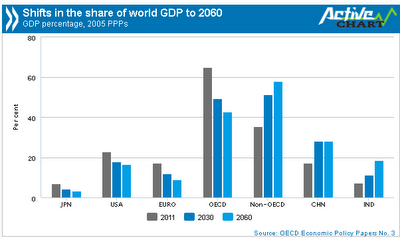

| Visitors Now: | |
| Total Visits: | |
| Total Stories: |

| Story Views | |
| Now: | |
| Last Hour: | |
| Last 24 Hours: | |
| Total: | |
OECD World Economy Outlook out to 2060
From
A paper, Who Shrunk China? Puzzles in the Measurement of Real GDP by Robert C. Feenstra, Hong Ma, J. Peter Neary, D.S. Prasada Rao argue that IMF’s estimate of China’s GDP for 2005 was 50% too low. (37 pages)
Their analysis is important, not just because it is carefully done, but also because Professor Feenstra will be leading the effort to produce the next generation of the Penn World Table GDP (PPP-based) estimates.
If they are right, and if I therefore might have underestimated China’s 2010 GDP (PPP dollars) by about 20 to 23 percent, three conclusions follow.
This implies China’s 2010 GDP PPP exceeded $17 trillion and in 2012 will reach $20 trillion.
India would also be understated by about 40-50% if the updated analysis is correct.
The balance of economic power is expected to shift dramatically over the next half century, with fast-growing emerging-market economies accounting for an ever-increasing share of global output, according to a new OECD report.
Divergent long-term growth patterns lead to radical shifts in the relative size of economies. The United States is expected to cede its place as the world's largest economy to China, as early as 2016. India’s GDP is also expected to pass that of the United States over the long term. Combined, the two Asian giants will soon surpass the collective economy of the G7 nations. Fast-aging economic heavyweights, such as Japan and the euro area, will gradually lose ground on the global GDP table to countries with a younger population, like Indonesia and Brazil.
China will see more than a seven-fold increase in per capita income over the coming half century, but living standards will still only be 60% of that in the leading countries in 2060. India will experience similar growth, but its per capita income will only be about 25% of that in advanced countries.
“None of these forecasts are set in stone,” Mr. Gurría said. “We know that bold structural reforms can boost long-term growth and living standards in advanced and emerging-market economies alike.”
OECD research shows that wide-ranging labour and product market reforms could raise long-term living standards by an average of 16% over the next 50 years relative to the baseline scenario, which only assumes moderate policy improvements.
See more and subscribe to NextBigFuture at 2012-11-09 17:01:48 Source: http://nextbigfuture.com/2012/11/oecd-world-economy-outlook-out-to-2060.html
Source:



